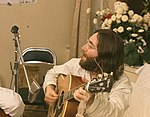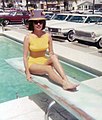
Fashions in the early years of the decade reflected the elegance of the First Lady, Jacqueline Kennedy. In addition to the pillbox hat which is discussed in detail below, women wore suits, usually in pastel colors, with short boxy jackets, and over-sized buttons. Simple, geometric dresses, known as shifts, were also in style. For evening wear, full-skirted ball gowns were worn; these often had a low décolletage and had close-fitting waists. For casual wear,Capri trousers were the fashion for women and girls.
Stiletto-heeled shoes were widely popular.
As the suits drifted away from pale, toned shades, menswear was now bright and colorful. It included frills and cravats, wide ties and trouser straps, leather boots and even collarless jackets. Ties were worn even five inches wide, with crazy prints, stripes and patterns. Casual dress consisted of plaid button down shirts with comfortable slacks or skirts.[6]
[edit]Mid-1960s
After designer Mary Quant introduced the mini-skirt in 1964, fashions of the 1960s were changed forever. The mini skirt was eventually to be worn by nearly every stylish young female in the western world.
The mini dress was usually A-line in shape or a sleeveless shift.[7] Also they wore big hats in very bright colors. This was introduced in 1966. Right after the "tropical years".
In 1964, French designer Andre Courreges introduced the "space look", with trouser suits, white boots, goggles, and box-shaped dresses whose skirts soared three inches above the knee. These were mainly designed in fluorescent colours and shiny fabrics such as PVC and sequins.[8]
The leaders of mid 1960s style were the British. The Mods (short for Modernists) were characterized by their choice of style different from the 1950s and adopted new fads that would be imitated by many young people. As the Mods strongly influenced the fashion in London, 1960s fashion in general set the mode for the rest of the century as it became marketed mainly to young people. Mods formed their own way of life creating television shows and magazines that focused directly on the lifestyles of Mods.[9] British rock bands such as The Who, The Small Faces, and The Kinks emerged from the Mod subculture. The Mods were known for the Modern Jazz they listened to as they showed their new styles off at local cafes. They worked at the lower end of the work force, usually nine to five jobs leaving time for clothes, music, and clubbing.[10] It was not until 1964 when the Modernists were truly recognized by the public that women really were accepted in the group. Girls had short, clean haircuts and often dressed in similar styles to the male Mods.[11] The Mods' lifestyle and musical tastes were the exact opposite of their rival group known as the Rockers. The rockers liked 1950s rock-and roll, wore black leather jackets, greased, pompadour hairstyles, and rode motorbikes. The look of the Mods was classy; they mimicked the clothing and hairstyles of high fashion designers in France and Italy; opting for tailored suits, which were topped by anoraks that became their trademark. They rode on scooters, usually Vespas or Lambrettas. The Mods dress style was often called the City Gent look. Shirts were slim, with a necessary button down collar accompanied by slim fitted pants.[12] Levi's were the only type of jeans worn by Modernists. Flared trousers and bellbottoms led the way to the hippie stage introduced in the 1960s. Variations of polyester were worn along with acrylics.[13]
Carnaby Street and Chelsea's Kings Road were virtual fashion parades. In 1966, the space age was gradually replaced by the Edwardian, with the men wearing double-breasted suits of crushed velvet or striped patterns, brocade waistcoats, shirts with frilled collars, and their hair worn below the collar bone. Rolling Stones guitarist Brian Jones epitomised this "dandified" look. Women were inspired by the top models of the day which included Twiggy, Jean Shrimpton, Colleen Corby, Penelope Tree, and Veruschka. Velvet mini dresses with lace-collars and matching cuffs, wide tent dresses andculottes had pushed aside the geometric shift. False eyelashes were in vogue, as was pale lipstick. Hemlines kept rising, and by 1968 they had reached well above mid-thigh. These were known as "micro-minis". This was when the "angel dress" made its appearance on the fashion scene. A micro-mini dress with a flared skirt and long, wide trumpet sleeves, it was usually worn with patterned tights, and was often made of crocheted lace, velvet, chiffon or sometimes cotton with a psychedelic print such as those designed by Emilio Pucci. The cowled-neck "monk dress" was another religion-inspired alternative; the cowl could be pulled up to be worn over the head.[14] For evening wear, skimpy chiffon baby-doll dresses with spaghetti-straps were the mode as well as the "cocktail dress", which was a close-fitting sheath, usually covered in lace with matching long sleeves.[15] Feather boaswere occasionally worn.
In 1964, Bell-bottomed trousers were a new alternative to the capris of the early 1960s. They were usually worn with chiffon blouses, polo-necked ribbed sweaters or tops that bared the midriff.
The look of corsets, seamed tights, and skirts covering the knees had been abolished. The idea of buying urbanized clothing, which could be worn with separate pieces, was intriguing to women of this era in comparison to previously only buying specific outfits for certain occasions.[16]
For daytime outerwear, short plastic raincoats, colourful swing coats and dyed fake-furs were popular for young women. In 1966, the Nehru jacket arrived on the fashion scene, and was worn by both sexes. Suits were very diverse in color but were for the first time ever, fitted and very sliming. Waistlines for women were left unmarked and hemlines were getting shorter and shorter.
Footwear for women included low-heeled sandals and kitten-heeled pumps, as well as the trendy white go-go boots. Shoes, boots, and handbags were often made of patent leather or vinyl. The Beatles wore elastic-sided boots similar to Winkle-pickers with pointed toes and Cuban heels. These were known as "Beatle boots" and were widely copied by young men in Britain.
[edit]Late 1960s
By 1968, the androgynous hippie look was in style. Both men and women wore frayed bell-bottomed jeans, tie-dyed shirts, workshirts, and headbands. Wearing sandals was also part of the hippie look for both men and women. Women would often go barefoot, and some even went braless.
Fringed buck-skin vests, flowing caftans, Mexican peasant blouses, gypsy-style skirts, scarves, and bangles were also worn by teenage girls and young women. Indian prints, batik and paisley were the fabrics preferred. For more conservative women, there were the "lounging" or "hostess" pyjamas. These consisted of a tunic top over floor-length culottes, and were usually made of polyester or chiffon.
Another popular look for women and girls which lasted well into the early 1970s was the suede mini-skirt worn with a French polo-neck top,[14] square-toed boots, and Newsboy cap or beret. Long maxi coats, often belted and lined in sheepskin, appeared at the close of the decade.[17] Animal prints were also popular for women in the autumn and winter of 1969. Women's shirts often had transparent sleeves. Psychedelic prints, hemp and the look of "Woodstock" came about in this generation.[18]
[edit]Hairstyles
Head coverings changed dramatically towards the end of the decade as men's hats went out of style, replaced by the bandanna, if anything at all. As men let their hair grow long, theAfro became the hairstyle of choice for African Americans. Mop-top hairstyles were most popular for white and Hispanicmen, beginning as a short version around 1963 through 1964, developing into a longer style worn during 1965-66, eventually evolving into an unkempt hippie version worn during the 1967-69 period which continued in the early 1970s. Facial hair, evolving in its extremity from simply having longer sideburns, to mustaches and goatees, to full-grown beards became popular with young men from 1966 onwards. Women's hair styles ranged from beehive hairdos in the early part of the decade to the very short styles popularized by Twiggy just five years later to a very long straight style as popularized by the hippies in the late 1960s. Between these extremes, the chin-length contour cut and the pageboywere also popular. The pillbox hat was fashionable, due almost entirely to the influence of Jacqueline Kennedy, who was a style-setter throughout the decade.
[edit]Additional fads and trends
The '60s also gave birth to the skinny jeans, worn by Audrey Hepburn, which again became popular with young men and women in the first decade of the 2000s.
The late 1960s produced a style categorized of people who promoted sexual liberation and favored a type of politics reflecting "peace, love and freedom".[19] Ponchos, mocassins, love beads, peace signs, medallion necklaces, chain belts, polka dot-printed fabrics, and long, puffed "bubble" sleeves were additional trends in the late 1960s.
New materials other than cloth (such as polyester and PVC) started to become more popular as well.
Starting in 1967, the Mod culture began to embrace reggae music and its working class roots. The new urban fashion known as Skinhead was born.
[edit]Image gallery
A selection of images representing the fashion trends of the 1960s:























No comments:
Post a Comment